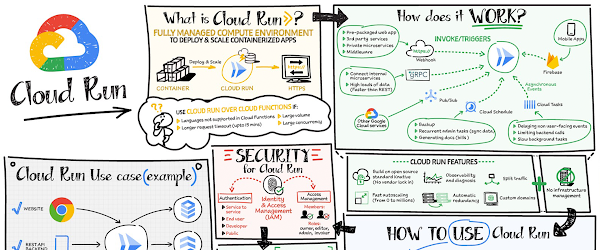Mindful Containers is a fictitious company that is creating containerized microservice applications. They need a fully managed compute environment for deploying and scaling serverless containerized microservices. So, they are considering Cloud Run.
They are excited about Cloud Run because it abstracts away the cluster configuration, monitoring, and management so they can focus on building the features for their apps.
What is Cloud Run?
Cloud Run is a fully-managed compute environment for deploying and scaling serverless HTTP containers without worrying about provisioning machines, configuring clusters, or autoscaling.
No vendor lock-in – Because Cloud Run takes standard OCI containers and implements the standard Knative Serving API, you can easily port over your applications to on-premises or any other cloud environment. Fast autoscaling – Microservices deployed in Cloud Run scale automatically based on the number of incoming requests, without you having to configure or manage a full-fledged Kubernetes cluster. Cloud Run scales to zero— that is, uses no resources—if there are no requests.Split traffic – Cloud Run enables you to split traffic between multiple revisions, so you can perform gradual rollouts such as canary deployments or blue/green deployments.Custom domains – You can set up custom domain mapping in Cloud Run and it will provision a TLS certificate for your domain. Automatic redundancy – Cloud Run offers automatic redundancy so you don’t have to worry about creating multiple instances for high availability
How to use Cloud Run
With Cloud Run, you write your code in your favorite language and/or use a binary library of your choice. Then push it to Cloud Build to create a container build. With a single command—“gcloud run deploy”—you go from a container image to a fully managed web application that runs on a domain with a TLS certificate and auto-scales with requests.
How does Cloud Run work?
Cloud Run service can be invoked in the following ways:
HTTPS: You can sendHTTPS requests to trigger a Cloud Run-hosted service. Note that all Cloud Run services have a stable HTTPS URL. Some use cases include:
Custom RESTful web APIPrivate microserviceHTTP middleware or reverse proxy for your web applicationsPrepackaged web applicationgRPC: You can usegRPC to connect Cloud Runservices with other services—for example, to provide simple, high-performance communication between internal microservices. gRPC is a good option when you::
Want to communicate between internal microservicesSupport high data loads (gRPC uses protocol buffers, which are up to seven times faster than REST calls)Need only a simple service definition you don’t want to write a full client library.Use streaming gRPCs in your gRPC server to build more responsive applications and APIsWebSockets: WebSockets applications are supported on Cloud Run with no additional configuration required. Potential use cases include any application that requires a streaming service, such as a chat application.
Trigger from Pub/Sub:You can use Pub/Sub to push messages to the endpoint of your Cloud Run service, where the messages are subsequently delivered to containers as HTTP requests. Possible use cases include:
Transforming data after receiving an event upon a file upload to a Cloud Storage bucketProcessing your Google Cloud operations suite logs with Cloud Run by exporting them to Pub/SubPublishing and processing your own custom events from your Cloud Run servicesRunning services on a schedule: You can use Cloud Scheduler to securely trigger a Cloud Run service on a schedule. This is similar to using cron jobs. Possible use cases include:
Performing backups on a regular basisPerforming recurrent administration tasks, such as regenerating a sitemap or deleting old data, content, configurations, synchronizations, or revisionsGenerating bills or other documentsExecuting asynchronous tasks: You can use Cloud Tasks to securely enqueue a task to be asynchronously processed by a Cloud Run service. Typical use cases include:
Handling requests through unexpected production incidentsSmoothing traffic spikes by delaying work that is not user-facingReducing user response time by delegating slow background operations, such as database updates or batch processing, to be handled by another service, Limiting the call rate to backend services like databases and third-party APIsEvents from Eventrac: You can trigger Cloud Run with events from more than 60 Google Cloud sources. For example:
Use a Cloud Storage event (via Cloud Audit Logs) to trigger a data processing pipeline Use a BigQuery event (via Cloud Audit Logs) to initiate downstream processing in Cloud Run each time a job is completed
How is Cloud Run different from Cloud Functions?
Cloud Run and Cloud Functions are both fully managed services that run on Google Cloud’s serverless infrastructure, auto-scale, and handle HTTP requests or events. They do, however, have some important differences:
Cloud Functions lets you deploy snippets of code (functions) written in a limited set of programming languages, while Cloud Run lets you deploy container images using the programming language of your choice. Cloud Run also supports the use ofany tool or system library from your application; Cloud Functions does not let you use custom executables. Cloud Run offers a longer request timeout duration of up to 60 minutes, while with Cloud Functions the requests timeout can be set as high as 9 mins. Cloud Functions only sends one request at a time to each function instance, while by default Cloud Run is configured to send multiple concurrent requests on each container instance. This is helpful to improve latency and reduce costs if you’re expecting large volumes.
Pricing
Cloud Run comes with a generous free tier and is pay per use, which means you only pay while a request is being handled on your container instance. If it is idle with no traffic, then you don’t pay anything.
Conclusion
After learning about the ease of set up, scalability, and management capabilities of Cloud Run the Mindful Containers team is using it to deploy stateless microservices . If you are interested in learning more, check out the documentation.
For more #GCPSketchnote, follow the GitHub repo. For similar cloud content follow me on Twitter @pvergadia and keep an eye out on thecloudgirl.dev
Cloud BlogRead More


